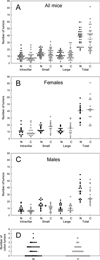High dietary niacin may increase prostaglandin formation but does not increase tumor formation in ApcMin/+ mice
- PMID: 21774590
- PMCID: PMC3224853
- DOI: 10.1080/01635581.2011.590266
High dietary niacin may increase prostaglandin formation but does not increase tumor formation in ApcMin/+ mice
Abstract
High doses of niacin (nicotinic acid) used to treat dyslipidemias cause flushing, due to high levels of prostaglandin D(2) (PGD(2)). GPR109A, a G-protein coupled receptor, triggers the flushing in the skin. In addition to boosting PGD(2), niacin binding to GPR109A activates the entire prostanoid cascade. We found that GPR109A occurs throughout the gastrointestinal tract. Mice that alternated between a 1% niacin diet and a control diet had higher urinary prostaglandin E(2) (PGE(2)) metabolite levels when on niacin (2.8-fold increase; 95% confidence interval, 1.8-3.9). PGE(2) promotes tumors in the intestines, whereas PGD(2) may have an opposite effect, on the basis of our report showing that transgenic hematopoietic prostaglandin D synthase suppresses intestinal adenomas in Apc(Min/+) mice. To determine if either tumor growth or tumor suppression prevails, we fed Apc(Min/+) mice a 1% niacin diet and assessed tumor development. A 1% niacin diet did not affect the number of tumors scored histologically in Apc(Min/+) mice at 14 wk (33 mice on niacin, 33 controls). Although niacin stimulates production of various prostaglandins, our results support an interpretation that very high intakes of niacin are safe in relation to intestinal tumors in this model.
Figures





References
-
- Offermanns S. The nicotinic acid receptor GPR109A (HM74A or PUMA-G) as a new therapeutic target. Trends Pharmacol Sci. 2006;27:384–390. - PubMed
-
- Shah S, Ceska R, Gil-Extremera B, Paolini JF, Giezek H, et al. Efficacy and safety of extended-release niacin/laropiprant plus statin vs. doubling the dose of statin in patients with primary hypercholesterolaemia or mixed dyslipidaemia. Int J Clin Pract. 2010;64:727–738. - PubMed
-
- Morrow JD, Parsons WG, III, Roberts LJ., II Release of markedly increased quantities of prostaglandin D2 in vivo in humans following the administration of nicotinic acid. Prostaglandins. 1989;38:263–274. - PubMed
-
- Morrow JD, Awad JA, Oates JA, Roberts LJ., II Identification of skin as a major site of prostaglandin D2 release following oral administration of niacin in humans. J Invest Dermatol. 1992;98:812–815. - PubMed
Publication types
MeSH terms
Substances
Grants and funding
LinkOut - more resources
Full Text Sources
Molecular Biology Databases
Miscellaneous
